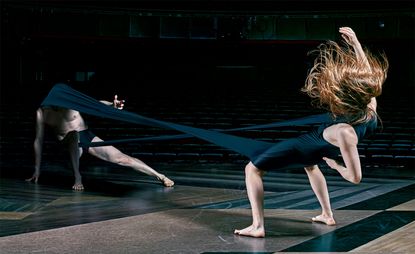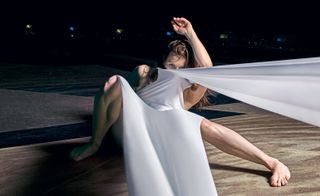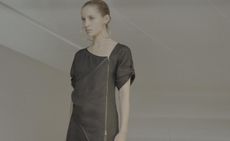Full stretch: fashion designer Hussein Chalayan directs a dance at Sadler’s Wells theatre

The A/W 2000 collection of London-based Cypriot fashion designer Hussein Chalayan was ’performed’ on the stage of Sadler’s Wells theatre. The collection was inspired by war refugees and their attachment to possessions, nodding to the then-recent conflict in Kosovo and Chalayan’s own experiences in Cyprus in the 1970s. The show was based around the things a family might want to take with them if war forced an evacuation. The stage was dressed as a living room, where small items could fit into pockets and large objects such as chairs would become clothes and suitcases. The last model walking on stage stepped into the middle of the coffee table, pulling it up to become a sculptural skirt - one of the pieces that still best identifies Chalayan’s work in fashion.
This autumn, the designer returns to that same stage to direct Gravity Fatigue, a contemporary dance show that Sadler’s Wells director Alistair Spalding invited him to develop. ’Hussein sent me a copy of a beautiful book about his work, and leafing through it I thought: he is more than just a fashion designer, he is an artist. We should create a project around him,’ says Spalding.
Two years in the making, the show debuts in October and touches upon themes of metamorphosis, identity, perception and displacement, all concepts that Chalayan has explored both in his fashion collections and his films, installations and sculptures.
It’s not the first time the designer has worked in contemporary dance. Over the years, Chalayan has collaborated with choreographers from Michael Clark to Sidi Larbi Cherkaoui, creating costumes for their performances. But, he says, ’it never occurred to me that I could do my own piece’.
Directing, then, is a serious step up. ’It’s much more complete in terms of ideas, and in my case this flow of ideas leads to a punctuation of movement’. On hand to help turn this punctuation into full sentences is choreographer Damien Jalet, who has translated Chalayan’s complex themes into movement.
’I love working with designers,’ says Jalet, ’because we work with the same tool: the human body. Hussein, in particular, constantly reinvents it, its function, its perception, our way to inhabit it; design is very compatible with choreography.’
Chalayan’s starting point for the dance was the costumes, rather than the dancers’ bodies themselves. ’The clothes are at the centre of many of the scenes; that is one of the most important aspects of the project, because it really is a marriage of shape and movement,’ he says. All designed by Chalayan, the costumes constrict the dancers’ moves, mould their bodies into sculptural shapes, affect their balance and strength, and help create his imagined landscape.
Wallpaper* Newsletter
Receive our daily digest of inspiration, escapism and design stories from around the world direct to your inbox
With the show’s debut several weeks away, a few elements are still being finalised, such as the music, which Chalayan is developing in close collaboration with Parisian sound stylist Mode-F. In the meantime, he has just launched his first store, in London, designed by his long-term collaborator Zoe Smith of ZCD Architects. Recently opened on Mayfair’s Bourdon Street, the boutique is a very much more concrete endeavour than his conceptual work at Sadler’s Wells. ’I am very interested in the difference between the physical and the abstract,’ says Chalayan. ’Through my work, I am trying to understand that gap between reality and the abstract world.
As originally featured in the September 2015 edition of Wallpaper* (W*198)

Chalayan with dancers Stephanie McMann and Marso Riviere, who star in his upcoming production. Interacting with the dancers has been his favourite part of this adventure. ‘I think they are conduits, a medium: they become a channel representing ideas in their own ways, and it’s really magical to watch,’ he says

The costumes constrict the dancers’ movements to create Chalayan’s imagined landscape. ‘I’m thinking of tableaux,’ he says
Rosa Bertoli was born in Udine, Italy, and now lives in London. Since 2014, she has been the Design Editor of Wallpaper*, where she oversees design content for the print and online editions, as well as special editorial projects. Through her role at Wallpaper*, she has written extensively about all areas of design. Rosa has been speaker and moderator for various design talks and conferences including London Craft Week, Maison & Objet, The Italian Cultural Institute (London), Clippings, Zaha Hadid Design, Kartell and Frieze Art Fair. Rosa has been on judging panels for the Chart Architecture Award, the Dutch Design Awards and the DesignGuild Marks. She has written for numerous English and Italian language publications, and worked as a content and communication consultant for fashion and design brands.
-
 Artist Mickalene Thomas wrestles with notions of Black beauty, female empowerment and love
Artist Mickalene Thomas wrestles with notions of Black beauty, female empowerment and love'Mickalene Thomas: All About Love’, a touring exhibition, considers Black female representation
By Hannah Silver Published
-
 New Phaidon book celebrates the world's best designers
New Phaidon book celebrates the world's best designersDesigned for Life: The World’s Best Product Designers by Phaidon celebrates the rich contemporary landscape of product design
By Tianna Williams Published
-
 The moments fashion met art at the 60th Venice Biennale
The moments fashion met art at the 60th Venice BiennaleThe best fashion moments at the 2024 Venice Biennale, with happenings from Dior, Golden Goose, Balenciaga, Burberry and more
By Jack Moss Published
